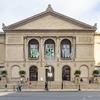More about Daniel-Henry Kahnweiler

Sr. Contributor
Daniel Henry Kahnweiler knew Pablo Picasso before he was cool.
Kahnweiler was a well-known art dealer, and an instrumental supporter of Picasso’s work. He was Cubism’s biggest fan and bought almost all of Georges Braque and Picasso's works for about seven years. After this portrait was completed, Kahnweiler made a contract with Picasso that kept Pablo out of the starving artist trope and financially secure until World War I happened.
Being a German citizen living in Paris at that time didn’t go well for Kahnweiler; he was declared an illegal alien and was unable to reenter the country. He wasn’t there when the news hit, though, as he’d been on a poorly timed vacation. When he was finally able to return…well, he suffered through one of the biggest art injustices ever: the government had claimed his gallery and all of his paintings - over three thousand of them - and this portrait was likely among them. Over the course of two years, they were all sold at auction.
In 1920, Kahnweiler opened a new gallery and eventually regained French citizenship. Then there was World War II. Kahnweiler was Jewish, and so was forced to go into hiding. Luckily, his stepdaughter purchased the gallery and oversaw it in his absence. Post D-Day, he got to return and act as the gallery director once again.
While Kahnweiler was not, to put it mildly, the luckiest in life, there were silver linings to be found, like this painting that serves as a memento of his close friendship with Picasso. Kahnweiler sat roughly thirty times for this fractured portrait, within which there are small glimpses of what would have been included in a more traditional painting: a tuft of hair, a watch chain, and his hands folded in his lap for example. In truth, his likeness could not have been captured more appropriately, as Kahnweiler went on to literally write the book on Cubism; he published The Rise of Cubism almost forty years later, in 1949.
Sources
- "Daniel-Henry Kahnweiler." The Art Institute of Chicago. Accessed July 20, 2020. https://www.artic.edu/artworks/111060/daniel-henry-kahnweiler.
- Gray, Maggie. "Picasso Satirised His Sitters – and Art Itself." Apollo Magazine. November 08, 2016. Accessed July 20, 2020. https://www.apollo-magazine.com/ picassos-portraits-satirised-his-sitters-but-also-art-itself/.
- "Kahnweiler, Daniel-Henry (born Heinrich Kahnweiler, Also Henry Kahnweiler)." Metmuseum.org. Accessed July 20, 2020. https://www.metmuseum.org/art/libraries-and- research-centers/leonard-lauder-research-center/research/index-of-cubist-art-collectors/ka
- "Portrait of Daniel-Henry Kahnweiler." Portrait of Daniel-Henry Kahnweiler by Pablo Picasso. Accessed July 20, 2020. http://www.pablopicasso.net/portrait-of-daniel-henry -kahnweiler/.
- The Editors of Encyclopaedia Britannica. "Daniel-Henry Kahnweiler." Encyclopædia Britannica. June 21, 2020. Accessed July 20, 2020. https://www.britannica.com/biography/Daniel- Henry-Kahnweiler-French-art-dealer-and-publisher.
Featured Content
Here is what Wikipedia says about Daniel-Henry Kahnweiler (Picasso)
Portrait of Daniel-Henry Kahnweiler (Spanish: Retrato de Daniel-Henry Kahnweiler) is an oil on canvas painting by Pablo Picasso in the Analytical Cubism style. It was completed in the autumn of 1910 and depicts the prominent art dealer Daniel-Henry Kahnweiler, who played an important role in supporting Cubism. The painting is housed in the collection of the Art Institute of Chicago.
Check out the full Wikipedia article about Daniel-Henry Kahnweiler (Picasso)













Daniel-Henry Kahnweiler is a painting by Pablo Picasso. Even this one is painted about a person, through the hands in the bottom we can see; the author didn't give a clear image about how the character is, all we can do is to imagine that and structure in our mind.